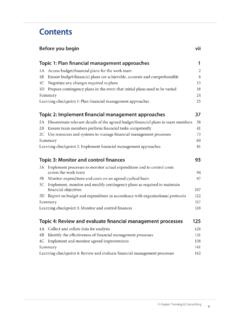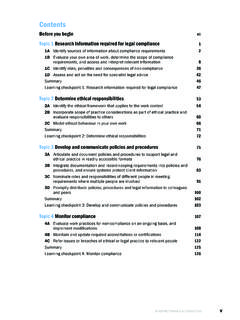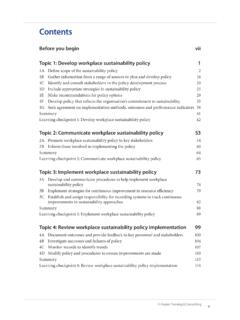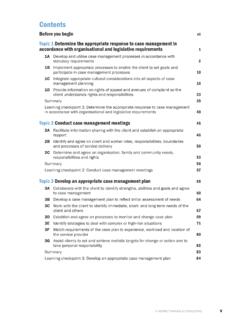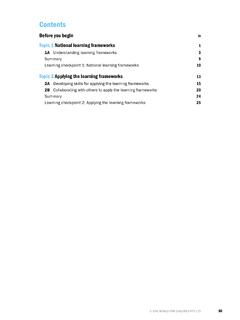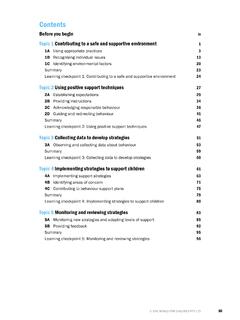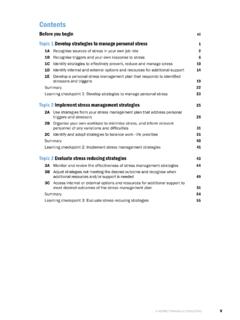Transcription of CHCECE011 Provide experiences to support children’s play ...
1 Contents Before you begin iv Topic 1 Creating an environment for play 1. 1A Understanding the value of play 3. 1B Supporting identity 14. 1C Providing for play 20. Summary 31. Learning checkpoint 1: Creating an environment for play 32. Topic 2 Supporting children's play and learning 35. 2A Engaging in play 37. 2B Meeting play needs 43. 2C Offering play choices 46. Summary 49. Learning checkpoint 2: Supporting children's play and learning 50. Topic 3 Facilitating children's play, learning and physical activity 51. 3A Participating in play 53. 3B Responding to children 58. Summary 60. Learning checkpoint 3: Facilitating children's play, learning and physical activity 61. iii Topic 1 Creating an environment In this topic you will learn about: for play Children learn about themselves and the world 1A Understanding the value around them through play. Providing a stimulating, of play challenging and safe environment allows children 1B Supporting identity to explore, discover and grow in their abilities.
2 An environment that allows children to make choices, 1C Providing for play and reflects their diversity, interests and abilities will enhance their play and leisure time. 1. Topic 1 Creating an environment for play As well as consolidating skills children have mastered, play enables them to use their bodies in many new and challenging ways; for example, climbing, standing, stretching, grasping and hopping. Physical activities assist children to: XX develop strength and stamina XX release excess energy XX learn hand eye and feet eye coordination XX develop balance. v 0062. Watch this video about children's physical development. Social, emotional and moral development Children also develop many social skills through play. They encounter situations where they learn to collaborate, choose experiences , make decisions, and experience failure and success. Pretend play assists children to explore the world of feelings and relationships. By playing out situations with others, children can come to terms with their world, particularly if they do not understand certain experiences .
3 Emotionally, children's growth is also fostered through play as they learn to manage a variety of feelings. Morally, children learn what is right and wrong through play, how to treat others fairly and what it is like to be treated unfairly. They also learn about their community, conservation and the environment as they share stories with others. By observing children at play, you can gain a sense of how play impacts a child's self- esteem, independence and sense of achievement. Play enables children to understand more about others and themselves, including their fears, joys and frustrations, and how they and others express themselves. Children might practise social skills through play like: XX taking turns XX cooperating and collaborating XX sharing XX setting rules and guidelines . XX negotiating Play is not bound by rules of language or culture it is open to children's own interpretations and expressions. Children may encounter situations in play that reflect those they will meet again later in life.
4 Through play, children are able to take on new roles, work through and cope with both positive and negative experiences , and learn what is necessary to establish relationships. From as early as two years old, children begin to notice physical differences in people, particularly differences relating to gender, colour and physical abilities. This is part of the children's self-discovery as they ask, Who am I?'. When children start forming relationships with others, they develop attitudes about differences. Children begin to work out who they are from their experiences with others; for example, they find out whether they are male or female; they become aware of the colour of their skin, eyes and hair; and they find out about their bodies and physical capabilities. 5. CHCECE011 Provide experiences TO support CHILDREN'S PLAY AND LEARNING. Development through play Example Cynda, an early childhood educator, has set up play dough. On the table she has provided a range of items: XX a rolling pin XX biscuit cutters XX scissors XX a collection of coloured pebbles and feathers.
5 The children working with the play dough each demonstrate different abilities. Development Abilities Physical XX rolling , pounding, cutting, moulding, etc. Social, emotional and XX Talking about their work moral XX Sharing play dough and materials with others XX Creating pretend play scenarios XX Discussing their work with others XX Manipulating the dough to match the emotion felt; for example, pounding out anger, squeezing the dough for stress release, etc. Cognitive XX Planning what to create XX Working out how to represent ideas Communication XX Telling others about their creations XX Chatting while working Spiritual XX Thinking about the play dough and its origin XX Connecting with the activity and thinking about how it feels to work with the dough Creative XX Imagining how to use the materials XX Creating an idea XX Manipulating the dough to the shapes desired Stages of play Social play refers to the way children play with others. Very young children have not gained the social skills to play effectively with others, so they are in a different stage of social play than children aged four years and over who play happily in groups.
6 People who study children's play have noted these differences and have classified them into different play types. Theorist Mildred Parten defined types of play that reflect the social dimensions of play. Parten's types of play: XX Solitary play XX Play with rules XX Parallel play XX Unoccupied play XX Associative play XX Onlooker play XX Cooperative play 8 ONE WORLD FOR CHILDREN PTY LTD. Topic 1 Creating an environment for play Play with rules Older preschool- and early primary school-age children become interested in more structured games; that is, those with clearly defined rules. Children often choose to play these games during their playtime at preschool, school or outside school care. Games with rules include: XX tabletop games, such as board games and card games XX games played in lines or circles XX games with balls, bats or marbles XX skipping rope games XX hopscotch XX cricket XX football. You can support play with rules by ensuring materials and equipment are in good order and are readily available to children.
7 Most play with rules requires space and an understanding of the rules of play. Children also need to collaborate with each other as they share what they know and agree on how the game will operate. Avoid competitive games where possible, as they reduce children's opportunities to practise skills. In competitive games, the children with the greatest skills get lots of practise, while the children with poor or less-developed skills are left out or are eliminated early. This reduces practice time, provides little chance for developing skills, and can also be damaging to self-esteem. In this situation children might become bored, upset or angry. By ensuring games are non-competitive, you ensure all children participate in some activity most of the time, and that there is not a winning team or winning child, but a group of children developing skills. Unoccupied play Children of all ages can become involved in unoccupied play, which involves a child being occupied watching anything that happens to be of momentary interest, rather than actively playing.
8 When there is nothing exciting taking place, the child may play with their own body, get on and off chairs, stand around, follow an educator or sit in one spot glancing around the room. Unoccupied play may not seem important, but you must respect a child's decision not to participate, and see the value in a child's observation of an environment and the people in it. Onlooker play Children of all ages can also become involved in onlooker play. A child who spends time watching other children at play is undertaking onlooker play. The child may talk to the children they are observing by asking questions or giving suggestions, but does not enter into the play. This type of play differs from unoccupied play in that the onlooker is definitely observing particular groups of children rather than anything that happens to be of interest at the time. The child stands or sits within speaking distance of the group so they can see and hear everything that takes place.
9 As with unoccupied play, onlooker play may not seem important, but you must respect a child's decision not to participate, and see the value in a child's observation of an environment and the people in it. 11. Topic 1 Creating an environment for play 2. This photo shows a small group of four- and five-year-old children playing. What value might this play have for their development? Consider their physical, social, emotional, cognitive and communication development. 3. Why do you think it is important to understand the stages of children's play? 4. Describe a play space you could set up that would be suited to solitary play. 5. Describe a play space you could set up that would be suited to cooperative play. 13. Topic 1 Creating an environment for play Practice task 2. 1. Complete the following checklist to assess an outdoor and indoor play environment, then answer the questions that follow. Yes No What to consider Photos/posters/pictures Are all the children's families and staff at the centre represented?
10 Are there images of people from a variety of ethnic, racial and cultural backgrounds? Are men and women depicted in less traditional roles; for example, women as carpenters and men as care providers? Are differently abled people depicted at work or at play? Is a variety of family types depicted; for example, single parents, an extended family or a same-sex family? Is artwork from different cultural groups displayed; for example, textiles with Aboriginal designs or Egyptian symbols? Books Do children's books reflect people of both modern and traditional cultural styles? Are other cultural/ethnic/racial backgrounds reflected positively? Do books reflect a variety of family lifestyles; for example, single- parent families, extended families and low-income families? Do books reflect a range of languages or stories in Braille? Do books reflect males and females in non-traditional roles? 17. 24. Infants to 1 year 1 to 2 years 2 to 3 years 3 to 5 years 5 to 9 years 9 to 12 years Visual Mobiles (that can Books with card Greater variety of Greater variety of Poetry, science and Science fiction (stimulate be seen while lying or cloth covers, books books gradually history books, magnifying and how-to'.))
